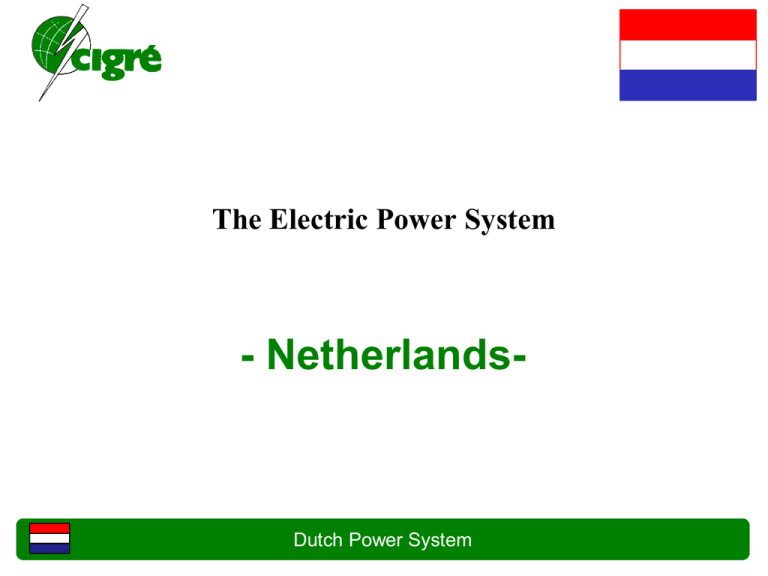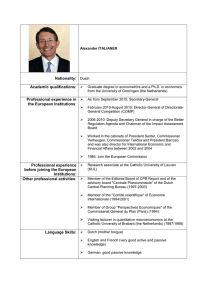Netherlands
advertisement

The Electric Power System - Netherlands- Dutch Power System Basic facts • Area: 41 543km² • Population: 16 877 351 (2014) • 1 TSOs • 10 DSOs (source: NetbeheerNederland) • 7,5 Mio. consumers (2012) (source: Netbeheer nederland) • Peak load: approx. 20,3 GW (source: TenneT TSOs) • Average interruption of electricity (2014): 20 min (sBetrouwbaarheid elektriciteitsnetten 2014 (NetbeheerNederland) Dutch Power System 1 Netherlands in the European meshed grid Interconnectors to: Norway; Belgium; Great Brittan; Germany; Denmark (planned); Source :ENTSO-E • Dutch Power System 2 Grid facts and characteristics Voltage Level Total length (approx.) Responsibility Transmission Grid 220 and 380kV 2 760 km TSO High Voltage 50 kV to 150 kV 9 037 km TSO/DSO Medium Voltage 3 kV to 25 kV 103 862 km DSO Low Voltage 230 V or 400 V 223 511 km DSO Dutch Power System Source :Netbeheer Nederland • The electricity grid in Netherlands is sub-divided into transmission grids (maximum voltage) and distribution grids (high, medium and low voltage) 3 TSO-Grid Structure of electrical power supply TSO Conventional Generation Bulk-Industry 380 kV 220 kV 150 kV or 110kV Industry 50/10 kV or 50/23kV 380 V Source : Amprion GmbH DSO-Grid Utilities Dispersed Generation Households DSO Dutch Power System 4 Source :TenneT TSO High Voltage Grid Dutch Power System 5 Cooperation of TSO and DSO: Cascade in Generation Dispatching of Renewables In case of (n-1)- security violations in the EHV-grid due to high dispersed generation TSO and DSO collaborate to lower the infeed of renewable generation in DSOs grid. TSO initiates and DSOs operate these measures according following cascade: TSO TSO Distribution grid 1. Level DSO Distribution grid 2. Level Distribution grid n. Level Grid area Generation DSO Hallo DSO DSO Load Dutch Power System 6 TSO Source: BDEW Transmission grid 6 Responsibilities within the cascade • TSO monitoring the overall system • Responsibility for SoS* • Operative contact to DSOs / generators on TSO-Level • Requests support by the DSOs DSO • Monitoring own system • Operative contact to generators on DSO-Level • Support of TSO to operate the cascade • Support of industrial customers to SoS through decreasing / increasing load • End user can be disconnected TSO Cascade Consumers Generation facilities • Support of TSO / DSO to SoS through decreasing / increasing the power of generation units *SoS = Security of Supply Dutch Power System 7 Trend Power production Netherlands Green Fossil Nuclear Natural gas DG Remaining Heavy oil Coal Natual gas Source: Umweltbundesamt Dutch Power System 8 Profile Energy consumption 2013 Refinery 3% 7% Food industry 7% Metal industry 15% Chemical industry Service 43% 3% Paper industry 4% Remaining metal industry 2% Civil construction 3% Remaining industry 1% Construction 10% Agriculture Water distribution and waste water 1% Fishing industry 0% Source: Netbeheer Nederland Dutch Power System 9 Renewables Dutch Power System 10 Location of RES Installed Solar panels Installed Wind turbines Installed PV panels A Amsterdam (NH): the number of inhabitants (790 110) B Súdwest Friesland (FR): largest area (813.05 sq km) C The Hague (ZH): most addresses with solar panels (2790) D Schagen (NH): most addresses with solar panels per 10 000 inhabitants (286) E Delft (ZH): most addresses with solar panels per km² (45) F Amsterdam (NH): most recorded PV capacity (4934 kWp) G Eersel (NB): Most PV capacity per capita (246 Wp / inhabitant) H Veenendaal (Ut): Most PV capacity per square kilometer (96 kWp / km²) I Eersel (NB): highest average plant size (27.5 kWp / address) Source: IWES Dutch Power System 11 Development of Wind Power On and offshore windpower Realised onshore wind power Source: CBS Realised wind power and targets 2020 and 2023 Dutch Power System 12 Development PV Power Production (mln kWh) Source: CBS Installed power (MW) Dutch Power System 13 Market Dutch Power System 14 Price development for electricity Average price including tax cent/kWh EU Average France Denmark Netherlands Germany Great Britan Source: Eurostat Dutch Power System 15 Cross-border markets The following cross-border market improvements are established the following cross-border systemic improvements or is still working on the implementation: • Market coupling Belgium - France - Netherlands (2008) • Market coupling Germany - Belgium - France - Netherlands (2010) • Intraday Cross Border (2011) • Intraday with Norway (March 2012), in England (May 2012) • Northwest European market coupling: Scandinavia, Great Britain and Central West Europe (Feb 2014) • Multi-Regional Coupling (MRC): Southeast Europe and Southwest Europe (May 2014). The MRC is the target model for further expansion in Europe into a single integrated cost-connected European day-ahead market. Dutch Power System German EEG concept Power Exchange Electricity Energy Market Proceeds from direct marketing Energy supply Costs / Proceeds marketing Horizontal balancing adjustment Marketing through control area TSO € EEG-Account EEG-Account EEG-Account area EEG-Account Control TSO Energy supply EEG apportionment Federal and financial funding less network charges Händler Händler Supplier Connection and Händler Händler compensation obligated SO RES Federal and financial funding grouted under EEG Vertical balancing adjustment Upon application: EEG apportionment EEG costreduction apportionment to to energy price own consumption Final consumer with own power production Privileged final consumer Dutch Power System EEG apportionment nationwided to energy price Final consumer 17


